By Babak Taghvaee
The Hellenic Air Force (HAF) has one of Europe's largest fleets of firefighting aircraft. On July 17, 2023, these aircraft became the first responders to assist the Hellenic Fire Service in tackling one of the largest blazes the country had ever faced to date. Massive wildfires erupted in several areas of the country, such as Attica, Corfu, Evia, Magnesia, and Rhodes, causing damage in excess of €600 million. The wildfire destroyed thousands of hectares of forests, buildings, and hotels and displaced over 20,000 people.

The 355 Firefighting Squadron, also known as 355 Tactical Transport Squadron (MTM) of the Hellenic Air Force, is equipped with eleven Canadair CL-215 firefighting aircraft based at Elefsis air base near Athens. The unit became involved in the battle against the catastrophic fires of July 17, early on the first day.
355th Tactical Transport Squadron
355th Tactical Transport Squadron (MTM), also known as a Firefighting Squadron, has a rich history dating back 76 years, the unit commencing operations for the first time in 1947. The 355th was initially headquartered at Ellinikos airport, its first aircraft, a Douglas C-47 Dakota transport aircraft. The squadron was initially named the 13th Light Bombardment Squadron. Moving to Elefsis airport near Athens in 1948. In 1950, the unit had seven C-47A's. The unit and their ground and air crews were deployed to South Korea to participate in the Korean War, assisting the UN forces with transporting wounded personnel, cargo, and weapons transportation. Ten years later, the squadron had two of its C-47s again involved in another peacekeeping mission to rescue a Greek element of the UN Peacekeeping force in Congo.

From airlifting military supplies and personnel from Elefsis to various air bases and airfields all around Greece, including in the Aegean and Mediterranean Islands, to performing tactical missions such as airdrops of Greek Army paratroopers were the tasks performed by the C-47s of the squadron. From 1968 to 1973, the squadron had five of its aircraft modified for air spraying missions for the benefit of the Greek Department of Agriculture. The aircraft was also capable of carrying water to use for firefighting missions.
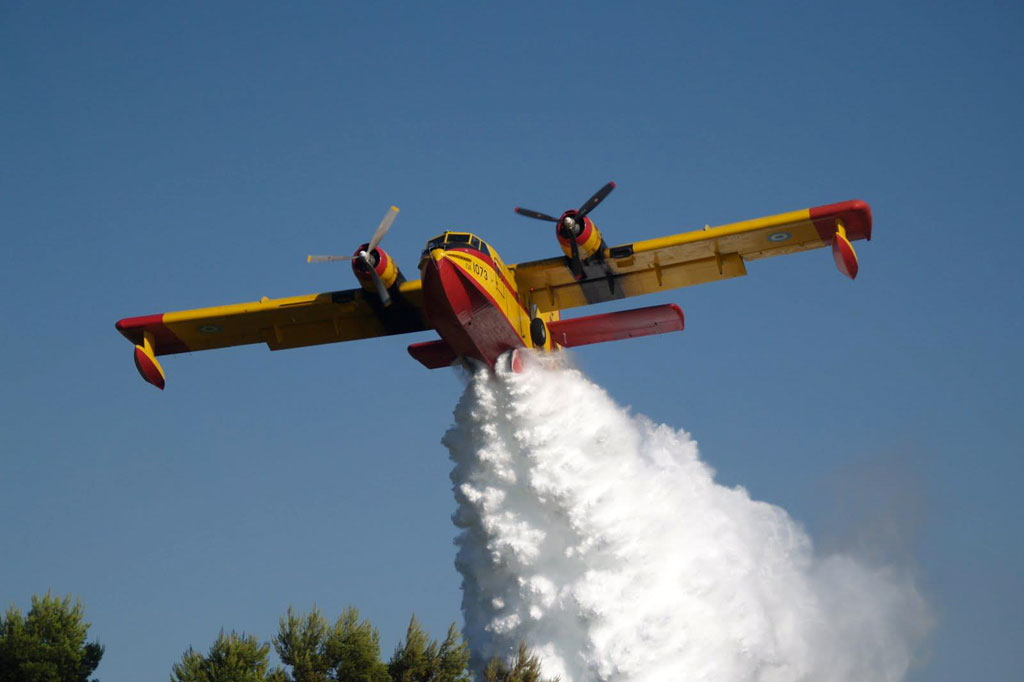
A year after the end of air spraying missions with the C-47s, 355 Transport Squadron received its first Canadair CL-215s. Delivery of the CL-215s resulted in a change in the unit's name. On December 22, 1975, the unit with five CL-215s in its service was named 355 MTM (Tactical Transport Squadron). A year after, another branch of the Hellenic Air Force, the 359 MAEDY (Public Services Air Support Unit), started operating firefighter aircraft, utilizing ten Grumman G.164A Ag-Cats. Thus, 359 MAEDY became the second unit in the Air Force to have aircraft dedicated to this mission in 1974.

From 1973 to 1979, HAF received eleven CL-215s, which all were put into service with 355 MTM. Five more CL-215s were later procured and received in the 1980s. The challenging and dangerous firefighting missions performed by the aircraft resulted in losses of some aircraft and their pilots. On May 26, 1977, and July 18, 1978, the unit lost two aircraft, 1042 and 1050 serial numbers, respectively. The first accident occurred during water scooping training near Korrnth, resulting in the death of all three crew members onboard. In contrast, the second aircraft was lost due to a fire initiated by a fuel leak near Ionia airport. None of its three crew members were harmed, although the plane was lost.
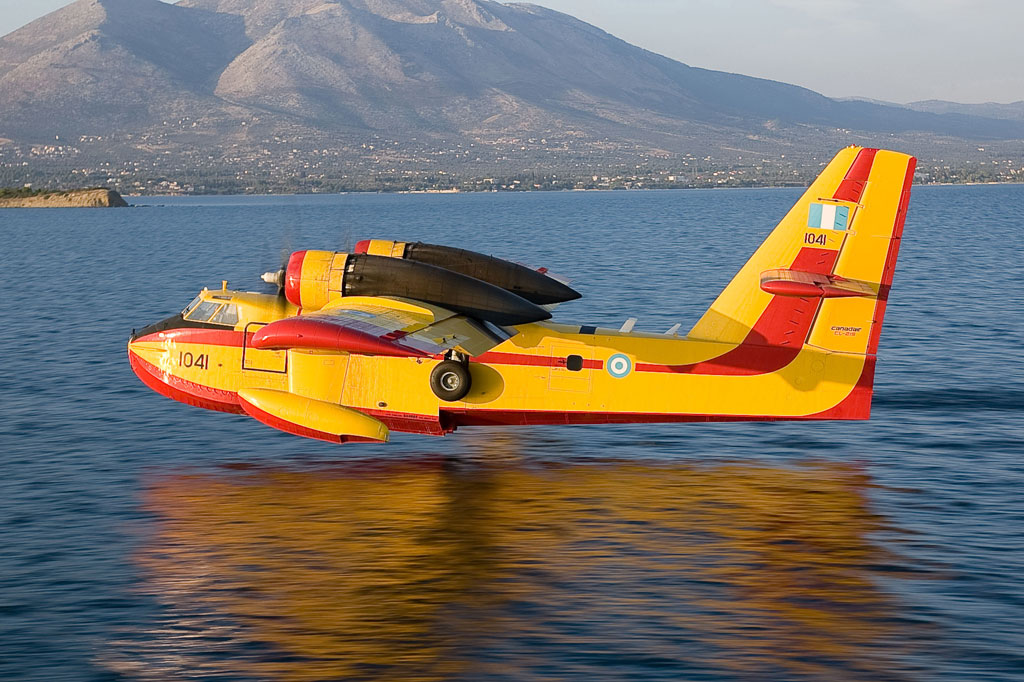
About the CL-215s of HAF
Equipped with a pair of Pratt & Whitney R-280083AM 18-cylinder radial piston engines, each making 2,100hp (1,600kW) power, a CL-215 can reach 291 km/h (181 mph, 157 knots) cruise speed and is capable of carrying 1,440 US gal (1200 imp gal, 5,450 L) of water, able to drop the load in 12 seconds. In addition, the aircraft of the 355 squadron can scoop salt water from the sea, and its water tanks can also be filled with retardant if needed by ground filling.
In 1997, Greece ordered ten CL-415s, which, with turboprop engines and improved avionics and other systems, were significantly superior to the CL-215. Their deliveries to the 355 MTM began in 1999 and finished in 2003. As the number of aircraft and personnel of the unit increased, HAF decided to form a second squadron using only CL-415s in Thessaloniki airport in the north of the country in 2003, leaving just CL-215s for the 355 MTM in 2004.
Before the loss of the CL-215 during the recent wildfires on July 25, 2023, 355 MTM always had nine of the unit's eleven CL-215s ready for firefighting missions during every fire season, from April 30 to November 1. To achieve this operational readiness, the maintenance unit of 355 MTM has always performed organization-level inspections of all aircraft during the non-fire season at the maintenance hangar of the squadron in Elefsis Air Base. In addition, Hellenic Aerospace Industries (HAI) performs depot-level maintenance or overhaul of one CL-215 per year. Each CL-215 needs one every six years.
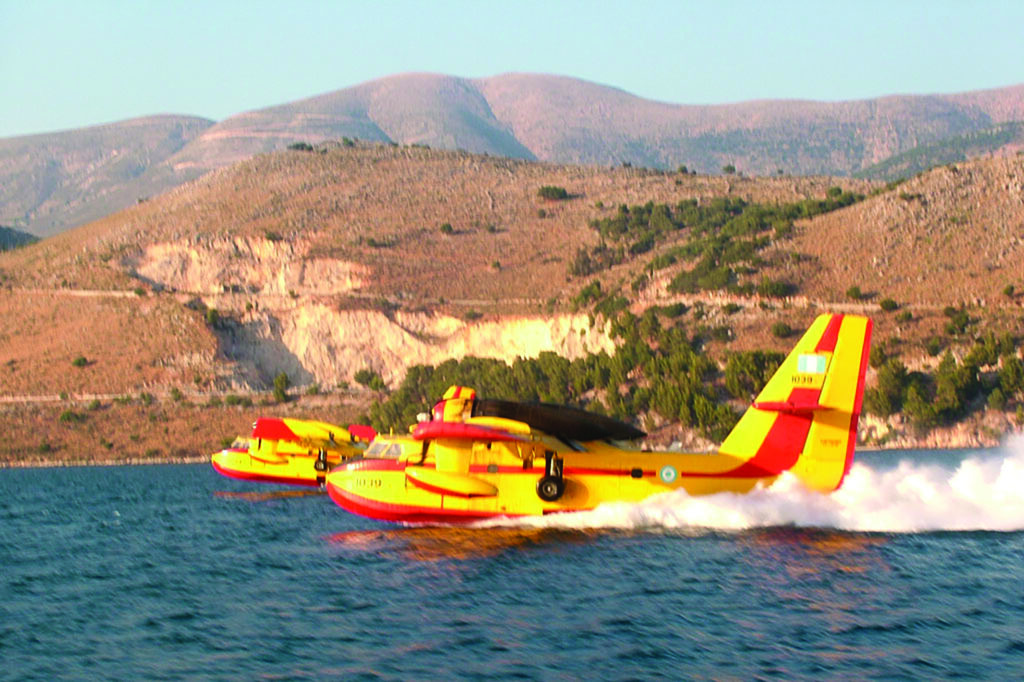
Despite having piston engines, the CL-215 has one advantage over the CL-415: its higher acceleration rate. Thanks to this, CL-215 pilots can perform their drops in mountainous regions as short as 100 feet above the ground. To achieve such a dangerous task, CL-215 pilots participate in one exercise before each fire season, usually in March or April every year. Before that exercise, CL-215 pilots renewed their water drop skills in a training area near Elefsis for one to two weeks.

Pilot training
Due to OPSEC (Operational Security), the Hellenic Air Force refused to share details of CL-215 pilot training and the process of selection of the pilots. The 355 MTM comprises 75 total staff members, 26 as pilots and five as instructor pilots. During the winter, the instructors will train new pilots to join the squadron and perform check rides for existing pilots. Due to the lack of weather radar on board the CL-215s, the number of flying sorties performed by the unit in winter drops extensively.

Pilots serving 355 MTM are divided into two groups. The first are pilots who have been in the aircraft since the beginning of their careers, joining the 355 MTM right after graduation from the Air Force Academy. In contrast, the second group are former fighter pilots with thousands of flying hours on fighter jets, such as Dassault Mirage 2000EG and McDonald Douglas F-4E Phantom II. Ex-fighter pilots can join the 355 MTM after transition training under the supervision of the Air Force Flight Academy.
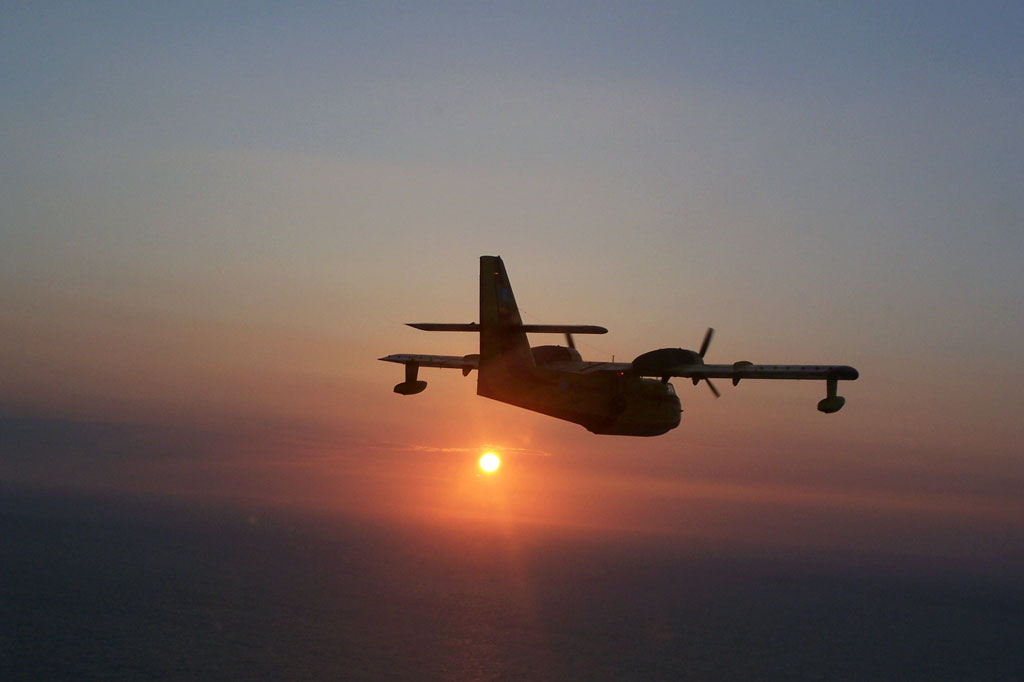
Those who join the squadron directly after graduation with the rank of 2nd Lieutenant have passed three years of training and have logged at least 150 flying hours. They first fly with Tecnam P2002JF primary training aircraft for 16 hours during the first year before their solo flight. After that, they have 19 more hours on the same type. After graduation from the primary flight training school, the trainees perform 48 hours of training flight on T-6A Texan II advanced pilot trainers in the second year and 54 to 70 more hours in the third year. After graduation, those selected to become CL-215 or CL-415 pilots pass training on T-2C/E Buckeye advanced jet trainers before joining 355 MTM.
The Wildfires of 2023
While in 2019, Greece had 61 air assets available to battle wildfires in the fire season, this was increased to 89 in 2023. Among the assets available for battling the wildfires in 2019, 35 fixed-wing aircraft comprising ten CL-215s, six CL-415s and 19 PZL M-18 Dromaders belonged to the HAF, three MBB/Kawasaki BK-117C1 and two Aérospatiale AS 332L1 Super Puma helicopters belonged to the Hellenic Fire Service and three CH-47D/SD Chinook helicopters belonged to the Hellenic Army Aviation while the remaining 18 were leased civilian firefighter helicopters.
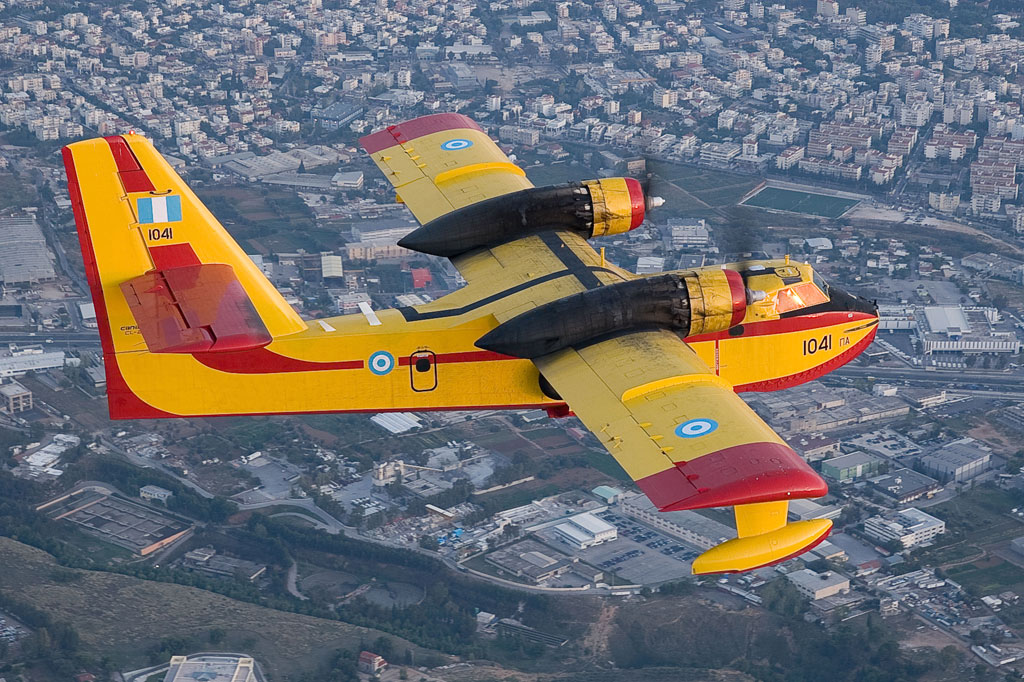
The 89 assets available for this task during the fire season of 2023 consisted of nine CL-215s, seven CL-415s and 16 M-18s, two Super Pumas and three MBB/Kawasaki BK-117C1s of the Hellenic Fire Service, three CH-47D/SD Chinooks of Hellenic Army, 17 leased Air Tractor AT-802Fs and 32 leased helicopters including eight Sikorsky/Erickson S-64 Skycrane helicopters from Erickson Inc. and multiple Bell 214 and Bell 214ST helicopters from McDermott Aviation Australia.

Despite having 89 aircraft and helicopters available for firefighting operations in Greece, the country needed more aerial firefighters to counter the massive wildfires of 2023. This put pressure on all the national assets, including CL-215s of the 355 MTM and their air and ground crews. Due to the safety rules of the Hellenic Air Force, each one of the pilots serving with the 355 MTM is allowed to perform three missions per day, each lasting between two to three hours.
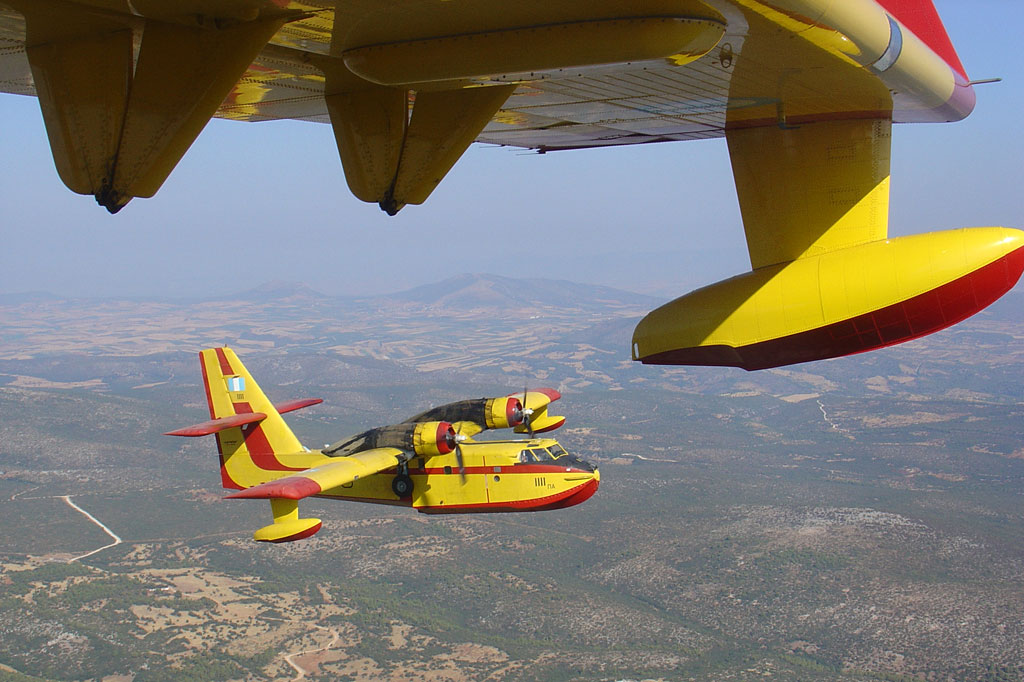
Despite all of the safety measures in place, one of the nine CL-215s of HAF involved in the firefighting missions crashed after its right wing's float collided with a tree while dropping water on a wildfire on a hillside at Karystos at 14:52 local time on July 25, 2023. After the float separated from the aircraft, it collided with the right wing flap, resulting in loss of aircraft control, resulting in the aircraft banking right and crashing into the hillside. Pilot and co-pilot Squadron Leader Christos Moulas and Captain Periklis Stefanidis lost their lives in the crash.
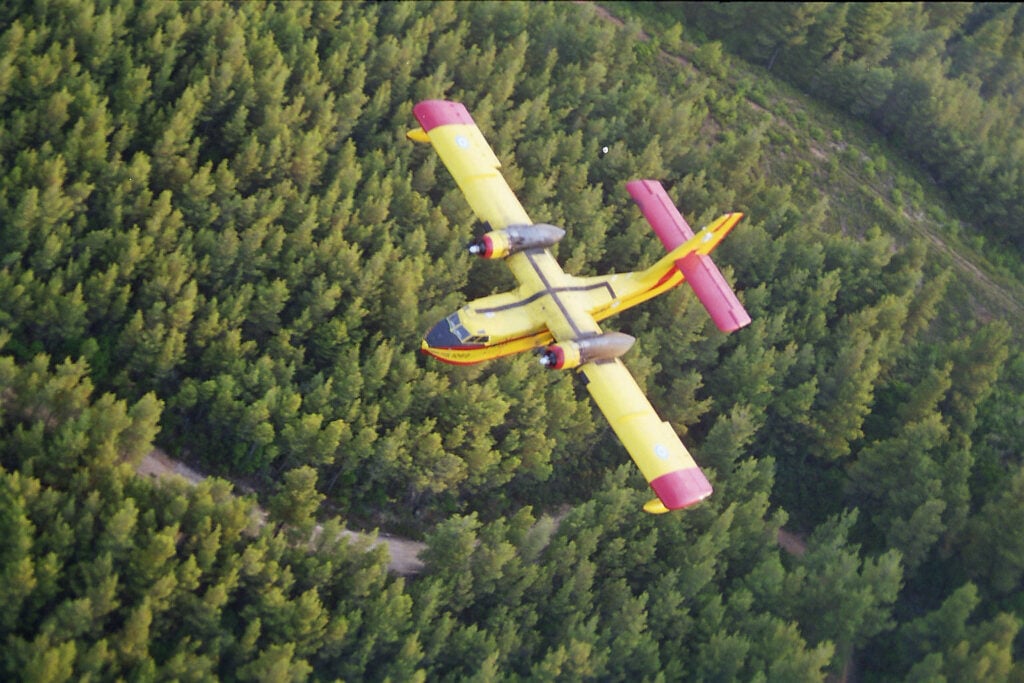
To assist Greece in tackling the massive wildfire, 13 countries offered the support of their firefighters, fire trucks, firefighting aircraft, and helicopters deploying to Greece as the 89 firefighting aircraft and helicopters available in the country were not enough to fight the raging inferno engulfing several areas around the country. The Croatian Air Force deployed one CL-415 aircraft, the Egyptian Air Force deployed three CH-47D Chinook helicopters, the French Sécurité Civile deployed two CL-415s, Italy's Vigili del Fuoco deployed two CL-415s, the Israeli Police force deployed two AT-802Fs, along with the Royal Jordanian Air Force deploying two Mi-26T2 heavy helicopters and Turkish Ministry of Forests deploying two AT-802As and one TAI T-70 GMH Black Hawk helicopter to battle the wildfires.
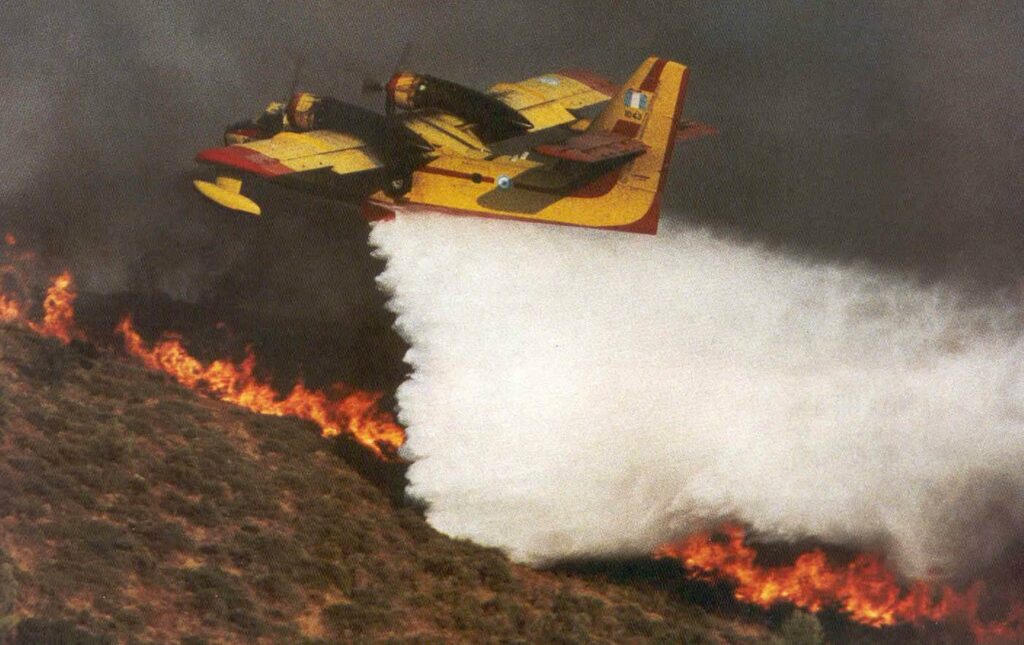
The CL-415s of the Thessaloniki-based 383 MEEA (Special Operations & Air Fire Fighting Squadron) currently operate seven aircraft, including one of the two examples equipped with weather radar and side-looking radars (SLARs) that, in addition to aerial firefighting, is also used for maritime search and rescue duties in all weather conditions.

The 383 MEEA collaborates closely with the 31st SAROPS (Search and Rescue Operations Squadron). Its rescue divers fly with the CL-415s during search and rescue missions. To battle the massive wildfire in the North of Limassol in Cyprus in August 2023, two CL-415s with 2052 and 2054 were deployed to Larnaca to assist the Cypriot Forestry Department and Police Aviation Unit in battling the fires.

To reduce the pressure on the aging fleet of CL-215 and M-18 Dromader firefighter aircraft, as well as the small fleet of seven CL-415s in service of the Hellenic Air Force, the government of Greece is currently studying plans to acquire a large number of modern firefighter aircraft such as AT-802Fs equipped with floats till that happens, Greece will continue leasing civilian firefighter aircraft and helicopters during every fire season.






